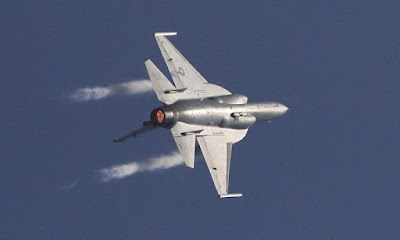Chinese aviation official has revealed that the Chengdu Aircraft Corporation FC-1/JF-17 fighter co-developed with Pakistan has been test-flown with a new Chinese medium-thrust turbofan engine.
Li Yuhai, an executive vice president with the Aviation Industries Corporation of China (AVIC), told IHS Jane's at the Paris Airshow that a new Chinese turbofan for the J-17 has been "under testing," has completed "lab tests", and that "flight testing is in progress". He also said that the new engine would have a thrust slightly greater than the 8.7-ton thrust of the JF-17's current Klimov RD-93 turbofan.
At a joint Sino-Pakistani press conference on 15 June, Li also said progress was being made on the twin-seat version of the JF 17.
Pakistani sources at Paris confirmed that a JF-17 has been flying with the new Chinese turbofan, which could be revealed publicly "very soon". There is a suggestion the engine could be named 'WS-17' to complement the JF-17b, but officials did not provide any further performance indicators.
 |
| JF-17 At Paris Air Show |
One Chinese medium-thrust turbofan programme long reported as slated for the FC-1/JF-17 has been called the WS-13 and reportedly flew in 2010. It has been developed with help from Russia's Klimov and is reportedly based on its RD-33 turbofan.
While previous reports mentioned development difficulties with the WS-13, the willingness of Chinese officials to talk publicly about this engine suggests a higher level of confidence in its prospects.
At the 2008 Airshow China in Zhuhai the Chengdu Gas Turbine Research Institute revealed it was developing a 9.5 ton-thrust turbofan and showed a possible model at the same show. It is not known if this is the engine that is now being test flown on a JF-17.
Despite the news of the new engine testing, Pakistani officials at Paris said they remain satisfied with the Klimov RD-93. In 2010 China obtained a Russian commitment to meet a potential requirement of up to 500 RD-93 engines to support the JF-17 programme. This figure would support Pakistan's requirements for up to 275 JF-17s plus international exports.
A Pakistani official also confirmed reports that the first export contract for the JF-17 has been signed. The official would only say that the contract had been signed in the first half of 2015 but would not name the customer.
Pakistani officials say they are having "serious" discussions with 11 countries, including Argentina, which a source confirmed is interested in co-producing the JF-17.
In its first appearance at Paris, the JF-17 is also accompanied by two new weapon options. One is the C-705KD missile, an IIR/TV-guided ground-attack version of the 140-170 km-range C-705 that was revealed at the 2012 Zhuhai airshow. A Pakistani source said up to four C-705KDs could be carried by the JF-17.
The second new weapon displayed with the JF-17 for the first time is the China Aerospace Science and Industry Corporation (CASIC) CM-102 anti-radiation missile. Revealed at the 2014 Zhuhai show, it has an advertised range of 100 km. A Pakistani source noted that other versions could have 50% to 70% further range.
Making its second international appearance was the CASIC CM-400AKG Mach-5 speed ground attack missile. A Pakistani official noted it did not have "passive" guidance, which might enable attacks against mobile targets such as ships, but has inertial navigational system/GPS guidance for attacking fixed targets.
Asked whether the CM-400AKG was in Pakistani service an official responded with a pointed "no comment".
Pakistan has produced 50 Block 1 versions of the JF-17 and has started production of 50 Block 2 versions. Officials said that discussions are underway with China for a Block 3 version that will include an active electronically scanned array (AESA) radar that is being developed by the Nanjing Research of Electronic Technology (NRIST).
Pakistani officials noted it could be based on NRIST's AESA radar developed for the Chengdu J-10B fighter but would not confirm any relation between the two systems. The Block 3 JF-17 will also incorporate a helmet-mounted display and a possible internal infrared search and tracking (IRST) system.
Read More At:




No comments:
Post a Comment